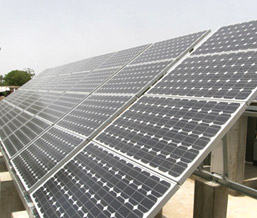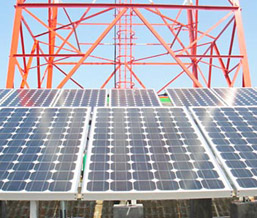

Solar Photovoltaic Modules
How Do Solar Panels Work?
A photovoltaic---systems convert sunlight into electricity. When sunlight is absorbed by the semiconductor materials that make up a solar panel, electrons are knocked loose from their atoms. This is called the "photoelectric effect." The free electrons travel into a circuit built into the solar cell and produce an electric current. The basic solar cell produces very small amounts of power, so many cells are interconnected to form the solar panel. These panels are then linked to create roof-mounted or rack-mounted solar arrays.
Size Matters
The cost of a solar panel is related directly to how many individual photovoltaic cells it contains, which in turn determines how much power in watts an individual solar panel can produce when struck by the sun's rays. The cost is often expressed in Indian Rupees. As examples, a 100-watt panel produced by Indian PV Manufacturing company was selling through an online distributor in June 2012 for Rs.100.00 per watt. A Mose Baer 210-watt panel was selling for Rs.160.00 per watt. These prices were for the purchase of one panel. During the same period, a bulk purchase can substaially reduce the cost.
How Are Solar Panels Made?
Silicon is fashioned into a crystal called an "ingot." This crystalline ingot is then cut into tiny discs, or wafers, less than a centimeter thick. After polishing, materials that produce an electrical charge in a semiconductor, called "dopants," are spread across the disk. This creates positive and negative poles, just as in a battery. Each wafer is wired with very thin threads and becomes an individual solar cell. The cells are aligned in a grid-like matrix and sealed behind a protective high-impact glass covering.
Why Do Panels Cost So Much?
The process of making a solar panel is extremely time intensive. The micro-miniature wiring that connects the individual cells has represented a major challenge in making photovoltaic panels inexpensive enough for mass adoption. Advances are being made in the methods that are used to wire the individual cells together into a functioning solar panel, but true mass production is still in the future. Also, in recent years there has been a shortage of the silicon required for producing the cells, which has kept panel costs high.
Will the Costs of Panels Come Down?
Supplies of solar-cell-grade silicon should begin increasing in 2010 and quadruple by 2012, which will help dramatically lower the costs of solar panel production. Also continuing developments in the newer thin-film technology will further reduce the costs of production. The thin-film manufacturers don't use silicon in their processes, but they will need to drop their prices to compete with the lowered prices of the conventionally produced solar panels. Another cost-cutting factor to keep an eye on is the growing number of rebates and tax initiatives being offered by the Central , state and local governments for installing solar panels to reduce dependence on electricity provided by Hydel ,coal-fired and natural-gas driven turbines.









